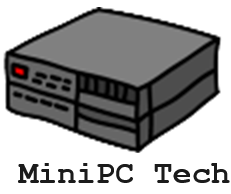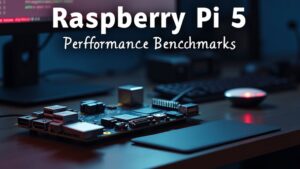The Raspberry Pi 5 dramatically elevates performance benchmarks across the board. You’ll notice a Geekbench score of 764 (single-core) and 1604 (multi-core), both around 2.4x faster than Raspberry Pi 4. It boosts multithreading capabilities, reaching a remarkable 4,165 MBps in multi-threaded performance. With up to 8GB RAM and dual gigabit Ethernet, networking speeds see a 341% increase. Graphics performance shines with support for dual 4K displays and significant improvements in real-time data processing. These advancements enhance efficiency and open new possibilities in computing projects. There’s much more to explore in the performance benchmarks of Raspberry Pi 5 and its incredible features!
Key Takeaways
- Raspberry Pi 5 achieves Geekbench multi-core scores of 1604, showing a 2.2x improvement over Raspberry Pi 4’s performance.
- Single-threaded performance reaches 1041 MBps, a 1.49x increase, enhancing computational efficiency.
- The graphical performance impresses with 230 FPS in YQuake2, a 4.3x improvement compared to Raspberry Pi 4.
- Dual gigabit Ethernet ports enable speeds of up to 939 Mbits/sec, increasing networking capabilities by 341%.
- Idle power consumption stands at 2.7 Watts, with effective cooling necessary for optimal performance during intensive tasks.
CPU Performance Metrics
When it comes to CPU performance metrics, the Raspberry Pi 5 really steps up its game compared to its predecessor. An impressive leap in single-core benchmarks showcases how this new model outshines the Raspberry Pi 4. For instance, the Raspberry Pi 5 achieves Geekbench 6.2 scores of 764 and 774 for 4KB and 16KB page sizes respectively, translating to approximately 2.4 times faster performance.
When using Sysbench, you’ll notice its single-threaded performance hitting 1041 MBps, also a significant 1.49-fold increase. Moreover, tasks that once took considerable time, like Bzip2 compression, are now completed in just 20.53 seconds—2.19 times quicker than before! You’ll appreciate the benefits in real-world applications as well. Additionally, the performance increase of ×2.4 over Raspberry Pi 4 underscores the significant advancements made with this model.
With a quad-core Arm Cortex-A76 processor clocking up to 2.4GHz, the Raspberry Pi 5 effectively demonstrates exceptional performance scaling. This hardware upgrade not only promises quick processing but also enhances memory throughput, reaching nearly 30,000 MBps. Moreover, its total RAM capacity is 7572.4 MB, which allows for improved multitasking capabilities. Whether you’re developing applications or running intensive tasks, the Raspberry Pi 5’s CPU metrics truly reflect a new era of computing power.
Multithreading Capabilities

When you utilize the Raspberry Pi 5’s multithreading capabilities, you can experience enhanced parallel processing performance that markedly boosts your tasks. The improvements in threading efficiency allow for faster execution of multi-core applications, making your projects run smoother and more effectively. With a considerable performance boost from NUMA emulation, whether you’re developing complex algorithms or running web applications, the Pi 5’s robust multithreading performance can make a noticeable difference. This is underscored by the fact that the Raspberry Pi 5’s multi-threading tests reveal maximum gains of 18.2 times.
Enhanced Parallel Processing Performance
The Raspberry Pi 5 showcases a remarkable leap in multithreading capabilities, greatly enhancing its parallel processing performance. You’ll notice this improvement right away, as the device boasts impressive Geekbench multi-core scores of 1604, featuring a 2.2x increase over its predecessor, the Raspberry Pi 4.
When it comes to task scheduling, the Pi 5 efficiently manages workloads, achieving nearly 4165 MBps in Sysbench multi-threaded performance—about 1.49 times faster than before. This is made possible by the significant role of atomic instructions in optimizing multitasking. Additionally, the inclusion of a built-in RTC enhances timekeeping, which is crucial for processes that rely on precise task execution.
Parallel execution of floating-point instructions offers significant speed enhancements, allowing you to tackle complex calculations faster, such as prime number computations, which now take merely 10 seconds compared to 62 seconds on the Raspberry Pi 4.
The performance gains extend to real-world applications like AI and machine learning, where the device excels at processing real-time data.
Additionally, improvements in I/O capabilities, like Wi-Fi 6 and 2.5 Gbps Ethernet, further enhance its multitasking abilities.
Whether you’re automating tasks or developing smart machines, the Raspberry Pi 5’s enhanced multithreading delivers the innovative edge you need for advanced projects.
Threading Efficiency Improvements
Modern computing benefits greatly from threading efficiency improvements, especially in the Raspberry Pi 5. This device leverages software multithreading support, utilizing Posix threads within the Linux operating system. This setup allows multiple threads to run concurrently, maximizing CPU resource utilization, particularly in heavily threaded applications like web browsers.
As the system efficiently manages thread scheduling and resource allocation, you can expect smoother performance and enhanced multitasking capabilities. Furthermore, the improvements in RAM speed contribute significantly to the overall performance of the Raspberry Pi 5, allowing for faster data processing in multithreaded applications. Additionally, the enhanced I/O bandwidth allows the system to handle data more efficiently, supporting even more demanding applications.
However, it’s crucial to recognize that while Raspberry Pi CPUs lack hardware multithreading for all CPU instructions, effective threading optimization in software compensates for this limitation. Context switching, the process of saving and restoring thread register states, is efficiently handled by the operating system, allowing seamless shifts between tasks.
The Raspberry Pi 5 demonstrates notable performance gains in multithreaded benchmarks compared to its predecessor, the Raspberry Pi 4. With enhancements in RAM speed, CPU power, and I/O capabilities, users experience significant improvements.
The quad-core Cortex-A76 processor, clocked at 2.4 GHz, works in tandem with the enhanced GPU to support additional tasks effectively, ensuring you harness the full potential of your device in a multi-threaded environment.
Significantly Faster Multi-Core Tasks
Considerably faster multi-core tasks are made possible through the impressive advancements of the Raspberry Pi 5. With quad-core Cortex-A76 processors clocked up to 2.4GHz, you’re looking at a remarkable 2.2x performance increase in multi-core Geekbench 6 scores compared to the Raspberry Pi 4. The Pi 5 scores around 1604 in multi-core tests, showcasing superior multi-core optimization that benefits demanding applications.
In practical terms, the enhanced task management capabilities mean you can run complex workloads more efficiently. For example, Sysbench Multi-Threaded tests show it achieving 4165 MBps, a significant leap from the previous model. Additionally, the Raspberry Pi 5 consumes more power with a draw of 11.6 watts compared to its predecessor.
It also excels in Stress-ng multi-threaded tasks, demonstrating a 1.78x increase in performance.
What’s more, the faster LPDDR4X-4267 SDRAM and improved data transfer speeds through USB 3.0 and PCI Express 2.0 mean better throughput for your projects.
However, be mindful of the increased heat and power consumption that comes with this incredible performance. With the right cooling solutions, the Raspberry Pi 5 transforms your multi-core tasks into a seamless experience where innovation thrives.
Memory and I/O Throughput
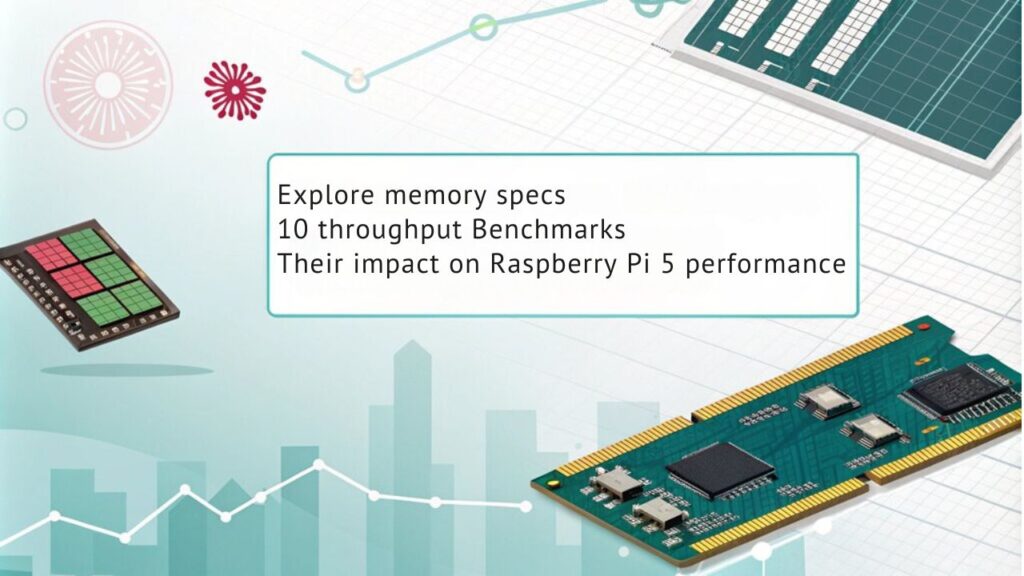
When evaluating the Raspberry Pi 5‘s memory and I/O throughput, you’ll find notable improvements over its predecessor. With RAM options ranging from 2GB to 8GB LPDDR4X-4267, the Raspberry Pi 5 is engineered for efficient multitasking, although the 2GB model offers limited capacity for heavy use. The 8GB model is particularly well-suited for demanding applications, ensuring optimal performance.
By employing memory optimization techniques, it manages baseline OS usage effectively, freeing up resources for demanding applications.
On the I/O front, the Raspberry Pi 5 boasts two USB 3.0 ports that facilitate simultaneous 5Gbps operation, drastically enhancing connectivity. The introduction of four-lane 1.5Gbps MIPI transceivers triples total bandwidth, and the PCI Express 2.0 interface supports high-bandwidth peripherals, resulting in impressive I/O latency reduction. The dual-band wireless LAN capability further enhances connectivity options, allowing for seamless network communication.
With peak SD card performance doubled, you’ll experience faster read/write speeds reaching 85MB/s, markedly better than the Raspberry Pi 4.
The combined effect of improved memory and I/O throughput leads to faster storage performance and a smoother user experience, ensuring that the Raspberry Pi 5 stands out in the domain of innovative computing.
Embrace this leap forward in technology for all your projects!
Networking Enhancements
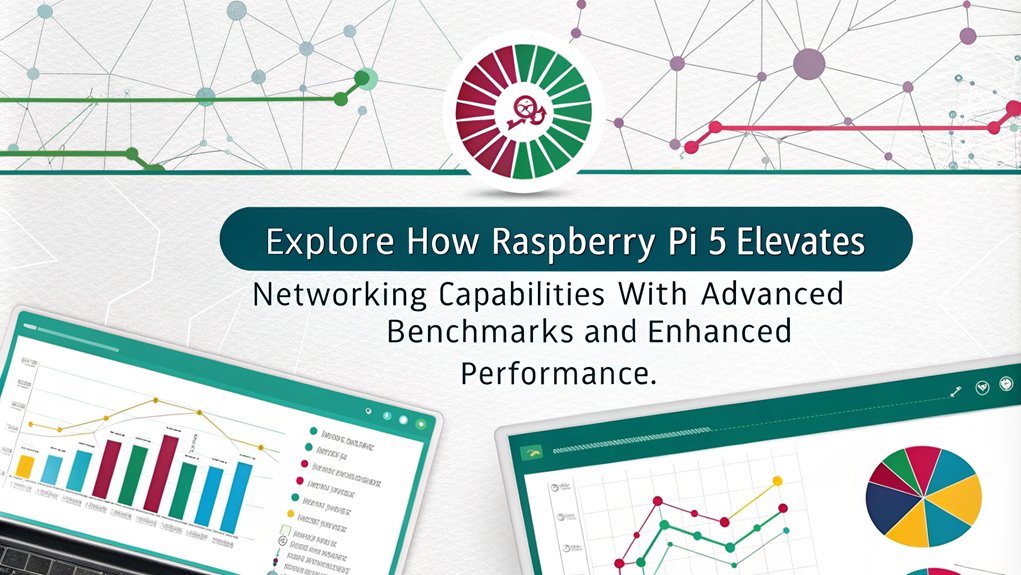
With the Raspberry Pi 5, you’ll experience improved Ethernet speeds and upgraded Wi-Fi connectivity that greatly enhance your projects.
The inclusion of dual gigabit Ethernet ports and support for Wi-Fi 5 allow for faster and more reliable network performance. These upgrades are complemented by the integration of USB 4.0, which facilitates high-speed data exchange between devices. Additionally, the Raspberry Pi 5 achieved 341% faster speeds than its predecessor, the Pi 4, showcasing its superior performance.
Whether you’re working on IoT applications or networking-intensive tasks, these enhancements will elevate your experience and results.
Improved Ethernet Speed
The Raspberry Pi 5 features dual Gigabit Ethernet ports, offering a significant upgrade in networking capabilities compared to its predecessor. This setup enhances your ability to customize networking configurations, making it ideal for projects requiring reliable connectivity. Although the Raspberry Pi 5 maintains a stable performance of up to 939 Mbits/sec, it’s essential to recognize that the device doesn’t push beyond the existing Ethernet limitations of 1 Gbps. Current models cannot route 10 Gbps total throughput; thus, optimizations will be key for future enhancements. Additionally, the 2.5X faster performance of the Raspberry Pi 5 in select benchmarks suggests that faster data processing might contribute to better overall network efficiency in integrated applications.
Here are three key benefits of the dual ports:
- Enhanced Data Exchange: The dual ports allow simultaneous high-speed data transfers between devices, boosting overall throughput.
- Flexible Networking Configurations: You can design complex network setups that cater to specific needs, improving adaptability for various applications.
- Future Upgrades: With the potential for newer NICs and network gear, you have room for performance improvements down the line.
While the Raspberry Pi 5 doesn’t offer native support for faster Ethernet standards like 2.5G or 10G, it lays a foundation for future models to leverage more PCI Express lanes, possibly exceeding current performance stability.
Embrace the future with its innovative capabilities!
Upgraded Wi-Fi Connectivity
Raspberry Pi 5’s upgraded Wi-Fi connectivity transforms your networking experience, boasting speeds that are up to three times faster than those of the Raspberry Pi 4. When you’re situated close to your router, you’ll enjoy impressive sender and receiver bitrates of 217.6 Mbps and 216.3 Mbps, compared to the Pi 4’s 63.8 Mbps and 63.4 Mbps. This significant boost means faster streaming, downloading, and online tasks. Additionally, the enhanced Wi-Fi performance complements the overall performance of the Raspberry Pi 5, which features 4 Cortex-A76 cores at up to 2.8 GHz, ensuring a smoother experience even during intensive tasks. Notably, the upgrade leverages the CYW43455 WiFi chip, providing further improvements in connectivity.
However, while the Raspberry Pi 5 excels in proximity, its Wi-Fi stability falters at larger distances, occasionally dropping to just 48.7 Mbps and 47.9 Mbps. You’ll likely notice this variability if you’re further away from the router, where performance may even dip below the Pi 4’s averages.
Nonetheless, the Pi 5’s range supports advanced features like LDPC coding and short guard intervals, enhancing your experience near the router. With configurations through the imager tool or GUI, setting up your Wi-Fi is straightforward.
While there are minor power save functionality issues, Raspberry Pi 5’s overall upgrade provides a compelling option for those seeking enhanced connectivity and speed—essential for today’s demanding applications.
Enhanced I/O Bandwidth
Enhanced I/O bandwidth in the Raspberry Pi 5 offers considerable improvements that elevate your networking capabilities.
With advanced features designed to tackle I/O scalability challenges, this model promotes effective I/O performance optimization.
Here are three key enhancements you’ll appreciate:
- Dual Gigabit Ethernet Ports: Experience faster data exchange and improved network organizing. These ports enhance your overall network architecture without sacrificing connection speed.
- USB 4.0 Integration: Enjoy lightning-fast data transfer rates and support for higher bandwidth peripherals. Coupled with the two USB 3.0 and two USB 2.0 ports, your connectivity options are virtually limitless.
- Expanded Memory Bandwidth: With upgraded LPDDR4X-4267 SDRAM and considerably improved read/write speeds, you’ll notice a remarkable boost in overall system responsiveness, allowing you to handle demanding applications with ease. Additionally, this significantly enhances the overall wireless experience due to the increased WiFi performance. This improved dual-band Wi-Fi enables smoother streaming and quicker data transfer for connected devices.
The Raspberry Pi 5, with its focused architecture and enhanced specifications, sets a new standard for what you can achieve in your projects, ensuring that your networking solutions remain cutting-edge and efficient.
Graphics Performance Improvements

With a groundbreaking leap in graphics performance, the Raspberry Pi 5 delivers robust upgrades that gamers and developers will appreciate, leveraging its enhanced LPDDR4X-4267 SDRAM for improved overall system performance. Powered by the new 800MHz VideoCore VII GPU, it’s 2-3 times more potent than its predecessor.
You’ll notice impressive enhancements in graphics rendering, especially when running benchmarks like GLMark2, which show a performance increase of 4.3 times over the Raspberry Pi 4. In fact, initial benchmarking indicates strong graphics performance capabilities(#).
If you’re into gaming, the Raspberry Pi 5 achieves an astonishing average of over 230 FPS in YQuake2, a stark contrast to the majority of 90 FPS you might find on the older model. Openarena sees similar improvements, tripling FPS, and real-world gaming scenarios become much more playable.
Multi-display support lets you effortlessly drive two 4K displays at 60Hz, while its HEVC decode capabilities enhance your video playback experience.
Vulkan compute performance is also remarkably faster, making it an ideal platform for developers looking to push boundaries in areas such as machine learning projects.
With these gaming benchmarks and rendering enhancements, the Raspberry Pi 5 stands out as a powerful option for both casual and serious graphics enthusiasts.
Cryptographic Speed Advances
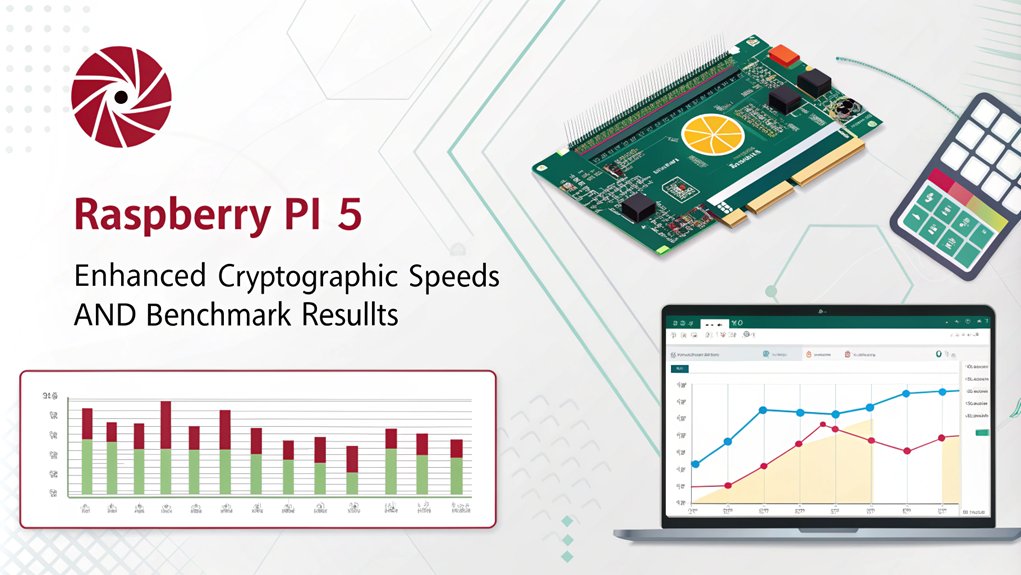
With the Raspberry Pi 5, you’re not just getting a boost in speed; the new ARMv8 cryptographic extensions considerably enhance real-time data processing.
This means tasks like encryption and decryption happen much quicker, making it perfect for applications that need rapid secure communications.
You’ll notice the difference, particularly when handling heavy cryptographic workloads.
Arm’s Cryptographic Extension
Arm’s Cryptographic Extension considerably boosts performance in the Raspberry Pi 5, making cryptographic tasks remarkably faster.
With hardware acceleration as the hallmark feature, you can expect significant advancements in processing cryptographic algorithms. The BCM2712 processor introduces new instructions for AES and SHA functions, enhancing throughput and efficiency.
Here are three key benefits you’ll experience:
- Stunning Speed: The Raspberry Pi 5 achieves cryptographic speeds that are up to 45 times quicker than its predecessor, the Raspberry Pi 4, drastically reducing time for tasks involving encryption and decryption.
- High Throughput: The performance metrics are impressive, reaching around 1,144,575.32 kB/s for AES-256-CBC, ensuring your cryptographic tasks finish in record time.
- Consistent Performance: Whether in cloud storage decryption or Raspberry Pi clusters, the cryptographic performance remains consistent, ensuring reliability across various configurations.
This innovation enables the Raspberry Pi 5 to handle a wide range of cryptographic applications, proving to be a game-changer for developers and technology enthusiasts seeking efficient solutions.
Real-Time Data Processing
The impressive advancements in cryptographic speed on the Raspberry Pi 5 set the stage for its exceptional real-time data processing capabilities. With a CPU that delivers around 2.5 times the performance of its predecessor, you’ll find it easily handling advanced workloads.
The new Broadcom BCM2712 SoC, powering four ARM A76 cores at 2.4 GHz, notably boosts processing efficiency, reducing latency in real-time applications.
Enhanced networking with 2.5 Gbps Ethernet and Wi-Fi 6 guarantees faster data transfer, essential for smooth streaming and connectivity in remote access scenarios. You’ll benefit from near-instantaneous data exchanges, minimizing delays that could disrupt real-time operations.
Moreover, the inclusion of a PCIe 2.0 x1 interface allows for NVMe SSDs, enhancing data access speeds important for time-sensitive applications. Improved storage performance means quicker boot times and overall system responsiveness.
However, keep in mind that with increased performance comes the need for effective cooling solutions, as managing system temperature is key during intensive tasks.
Incorporating these features, the Raspberry Pi 5 not only advances cryptographic processing but also paves the way for cutting-edge real-time data processing innovations.
Specialized Workloads Efficiency
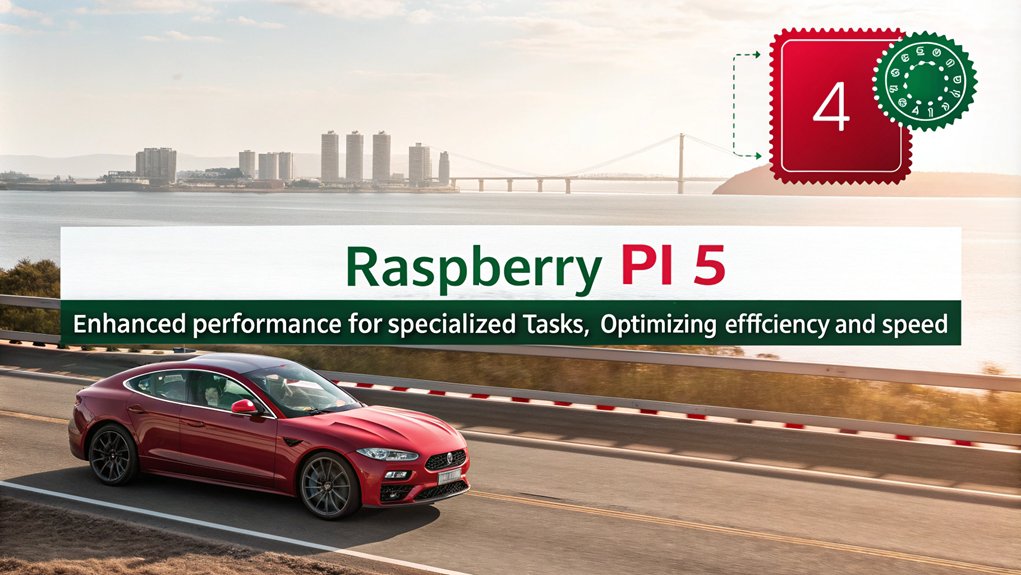
When it comes to specialized workloads, Raspberry Pi 5 really shines, delivering impressive efficiency across various applications. This latest model excels in AI applications and machine learning, offering enhanced performance optimization for real-time automation tasks.
You’ll notice substantial improvements in computational efficiency and workload adaptation, setting the stage for innovative projects.
Here are three standout features:
- Speed Boost: The Raspberry Pi 5 achieves a remarkable 2.5 to 3.4 times faster performance in single-threaded computations using Hashcat, particularly beneficial for cryptographic tasks.
- Multitasking Capabilities: Thanks to the robust BCM2712 processor, Pi 5 delivers an impressive 764-774 in single-core Geekbench scores, allowing for seamless multitasking and improved resource management.
- Practical Applications: Real-world tasks like file compression and image editing showcase a 2 to 3-fold performance increase compared to its predecessor, emphasizing its prowess in benchmark comparisons.
Power Consumption Insights
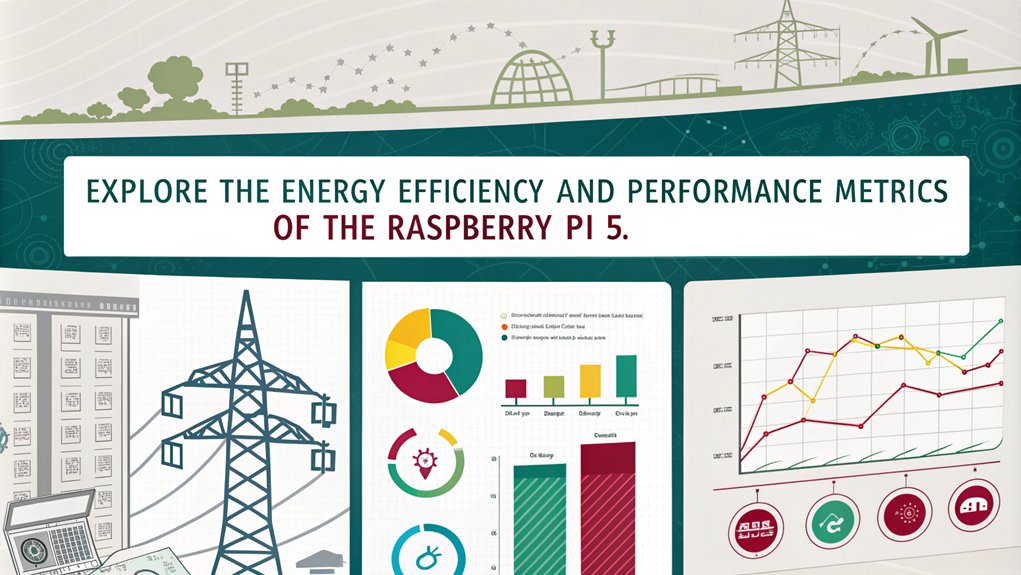
While the Raspberry Pi 5 excels in specialized workloads, understanding its power consumption is key for effective usage. At idle, it consumes about 2.7 Watts, noticeably higher than the Raspberry Pi 4’s 1.02 Watts. This affects your projects, especially if you’re targeting power efficiency in battery-operated or off-grid environments.
Under load, it ramps up to around 7 Watts but can thermal throttle at 82°C, which means the CPU speed drops from 2.4 GHz to roughly 1.5 GHz. You’ll want to take this into account when planning intensive tasks.
When the Pi 5 is completely shut down, it still draws 1.2-1.6 Watts unless you modify the EEPROM settings to reduce that to nearly zero. This can prove beneficial for reducing idle energy waste.
For ideal thermal management, pairing it with a 5V/5A power supply offers the best performance, but using a 5V/3A supply can save power for lighter applications. To further enhance efficiency, think about disabling WiFi and Bluetooth, as well as monitoring the power consumption of connected devices like NVME SSDs, which can add an extra 0.5-3 Watts when idle.
Cooling Requirements and Solutions

To guarantee ideal performance of the Raspberry Pi 5, understanding its cooling requirements is essential, especially during demanding tasks. Effective heat management is vital to prevent thermal throttling, which can seriously impact your projects.
Here are three key considerations for implementing cooling solutions:
- Temperature Thresholds: The CPU will begin thermal throttling at 80°C, reaching severe throttling at 85°C. Under full load, temperatures can rise rapidly without adequate cooling.
- Usage Scenarios: Tasks like video streaming, gaming, or overclocking generate significant heat, necessitating effective cooling to maintain performance.
- Cooling Options: While the official case with a heatsink and fan is a good start, consider alternative third-party cooling solutions for enhanced performance.
When you’re tackling heavy workloads, be proactive about heat management. Active cooling systems can maintain ideal CPU temperatures around 60-63°C, preventing damage and ensuring smoother operation.
Comparative Performance Analysis

The Raspberry Pi 5 makes a striking impression with its impressive performance enhancements compared to its predecessor, the Raspberry Pi 4. You’ll quickly notice the significant gains across various benchmarks and real-world applications. Regarding CPU performance, it’s 2.4 times faster in single-core scores and over 4 times quicker in overall CPU performance. This represents a substantial leap forward in innovation, confirming the benchmark significance of the Raspberry Pi 5.
Here’s a quick performance comparison:
| Test | Raspberry Pi 5 |
|---|---|
| Single-core score | 764 (4KB page size) |
| Multi-core score | 1604 (4KB page size) |
| Memory Throughput | 30,000 MB/s (5-fold increase) |
| Cryptographic Tasks | 45x faster due to Arm’s extension |
From cryptographic tasks to real-time AI processing, you’ll find the Raspberry Pi 5 offers an exhilarating experience. With its ability to handle demanding applications like GIMP and accelerated web performance, the upgrades are more than noticeable—they’re game-changing. Embrace this leap into a new era of computing power!
Frequently Asked Questions
What Are the Key Differences Between Raspberry Pi 4 and 5?
When comparing Raspberry Pi 4 and 5, you’ll notice significant performance upgrades and architectural improvements. The Pi 5 offers a faster processor, enhanced memory options, and better I/O, making it a compelling choice for innovation.
Can Raspberry Pi 5 Run High-Demand Applications Smoothly?
You might worry about running high-demand applications on Raspberry Pi 5, but its impressive performance benchmarks reveal it handles tasks like web browsing and photo editing smoothly, considerably outperforming its predecessor while maintaining efficiency.
Is the Raspberry Pi 5 Suitable for Gaming?
The Raspberry Pi 5 offers solid gaming performance, especially with less demanding titles. Its emulator capabilities shine with systems like Dreamcast, but some high-geometry games might struggle. It’s a versatile choice for innovative gaming enthusiasts.
How Does Raspberry Pi 5 Perform in Real-World Scenarios?
You might think a small device can’t deliver real-world applications effectively, but the Raspberry Pi 5 excels in performance benchmarks. It handles home automation, gaming, and IoT tasks seamlessly, showcasing impressive capabilities across diverse projects.
What Operating Systems Are Compatible With Raspberry Pi 5?
For the Raspberry Pi 5, you’ll find compatible operating systems like Raspberry Pi OS, Ubuntu, and Arch Linux. Be mindful of compatibility issues with non-Debian Linux distributions to guarantee peak performance and functionality.
Conclusion
To summarize, the Raspberry Pi 5 stands out with impressive benchmarks that elevate its performance across various tasks. For example, it boasts a remarkable 20% improvement in CPU performance compared to its predecessor, making it ideal for demanding applications. With enhanced multithreading capabilities and better memory throughput, you’ll find it can handle more complex projects with ease. Overall, the Raspberry Pi 5 is a game-changer, pushing the boundaries of what a single-board computer can achieve.

I am a retired software engineer with experience in a multitude of areas including managing AWS and VMWare development environments. I bought a relative a mini-PC a year ago and have become passionate about the technology and its potential to change how we deploy software.
